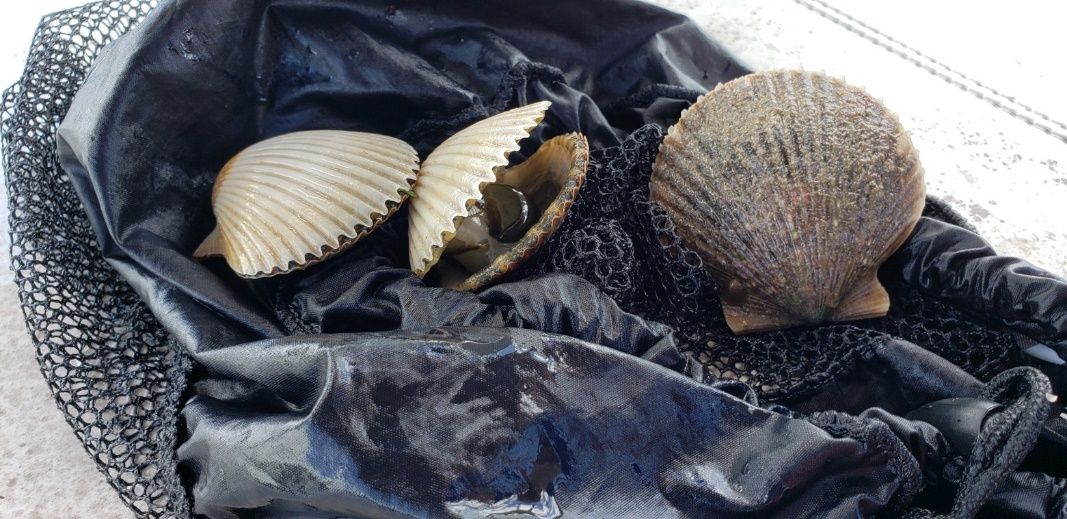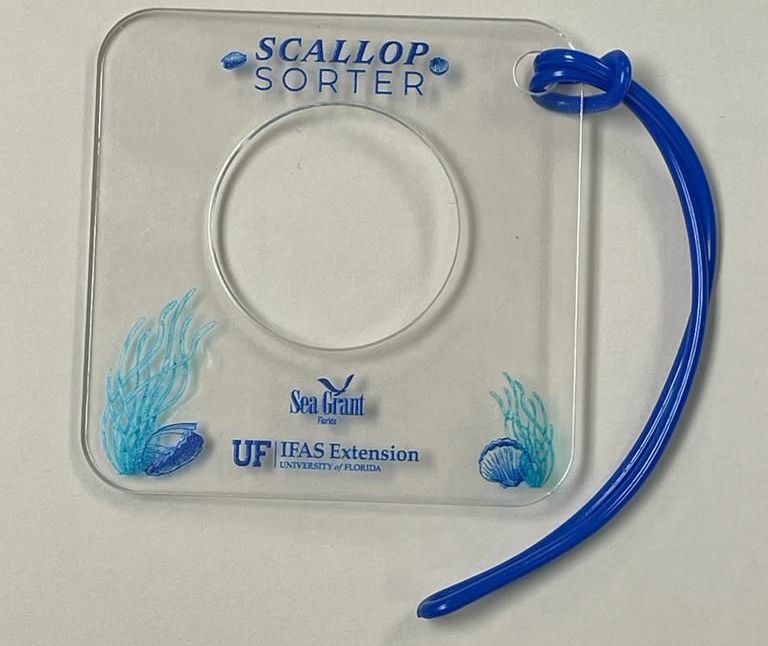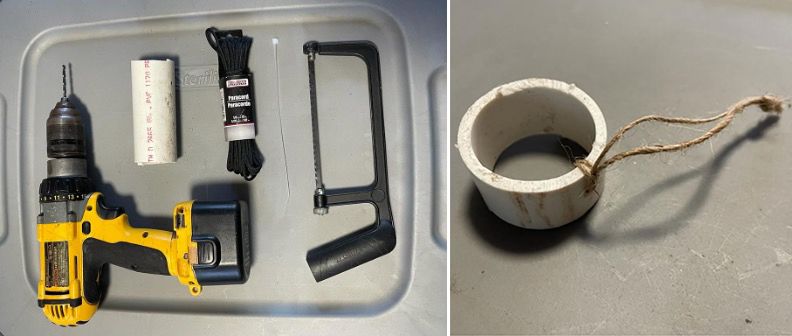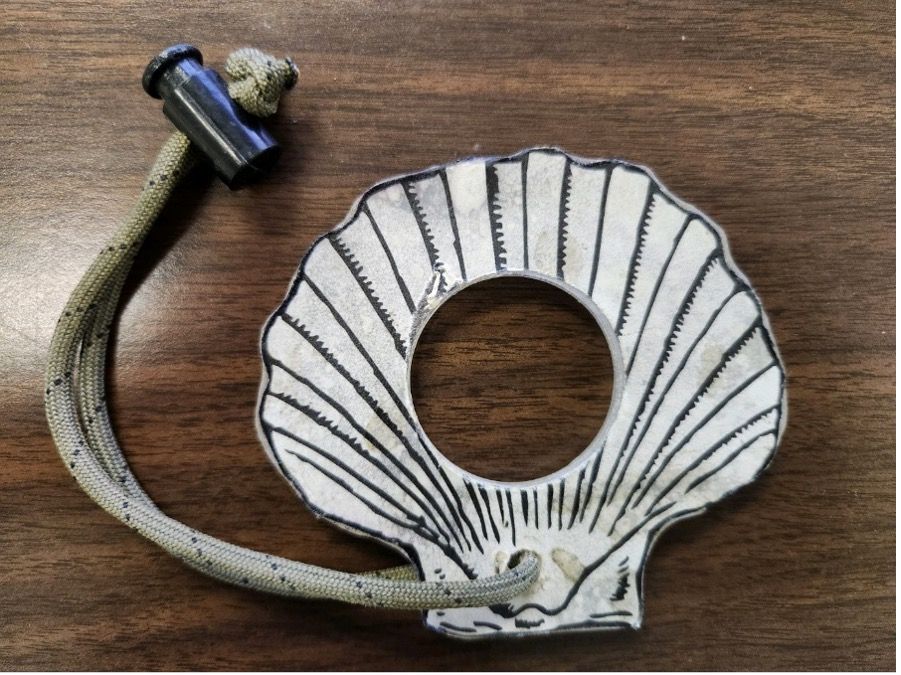Introduction
Each summer, recreational scalloping attracts participants from far and wide to Florida's Gulf Coast. Coastal counties that serve as vessel launch points receive significant economic benefits from this fishery (Hall-Scharf et al. 2018). However, the biology of the bay scallop and the environmental stressors it endures have led to limited populations of bay scallops along Florida's Gulf Coast (Granneman et al. 2021). Therefore, it is essential to implement best practices for harvesting bay scallops so that future generations can continue to enjoy scalloping. This publication gives recreational scallopers tips on how to sort through scallops in the water so that only those of harvestable size are taken and the smaller ones are returned immediately to the same spot where they were taken. Selecting only the larger scallops for harvest and returning the rest unharmed supports scallop population replenishment. Improving harvesting techniques can help sustain this valuable fishery and ensure that a popular recreational activity can continue for many summers to come.
Background
The bay scallop, Argopecten irradians, was once abundant along Florida's Gulf and Atlantic coasts (see Figure 1). In 1994, commercial harvesting of this fishery closed, and regulations were imposed on recreational harvesting (Granneman et al. 2021). Unfortunately, due to habitat loss, recruitment failures, harmful algal blooms, water quality issues, and overharvesting, bay scallops are now only found in limited populations along Florida's Gulf Coast (Geiger et al. 2010; Granneman et al. 2021).

Credit: Brittany Scharf, UF/IFAS
This highly dynamic species typically lives for 18 months (Geiger et al. 2010). The bay scallop's first peak reproduction period occurs in the fall, after the recreational harvest season (Granneman et al. 2021). Unfortunately, this harvest removes many scallops from the system before they can reproduce.
The Florida Fish and Wildlife Conservation Commission (FWC) manages recreational bay scallop harvest along Florida’s coast. The number of vessels participating in Florida’s recreational bay scallop fishery, the size minimum of individual scallops harvested, and the overall quantity of harvested scallops are not limited. However, there are regulations in place, including bag limits, season limits, methods of taking, and designated zones. In contrast to Florida's regulations, other bay scallop fisheries in the United States limit the harvesting of scallops that are at least 15 months old and enforce a size minimum (Granneman et al. 2021). For more information about regulations regarding the recreational harvesting of Florida's bay scallops, please visit the FWC website.
The derby-style nature of the fishery and the variability in bay scallop sizes have led to questionable harvesting practices in Florida. Confusion among anglers regarding measuring whole scallops by the gallon is also common. Florida regulations limit per-scalloper harvest by volumes of either whole scallops or shucked meat, and the maximum take is sometimes unequal by both measures (Geiger et al. 2010; Granneman et al. 2021).
Simulations that test reductions in bag limits and a later start for the harvest season indicate that these management tools could benefit Florida's bay scallop fishery in the long run (Chong et al. 2023). Implementing a later season, in other words pushing back the harvesting period to begin later in the year, would better align with the reproductive cycle of scallops. Florida’s bay scallop typically lives for around a year and starts reproducing in early fall. Delaying the season would allow more scallops to spawn before being harvested, bolstering the population for the future (Chong et al. 2023). Additionally, a rolling bag limit would be another effective way to safeguard the scallop population. Beginning the season with a lower limit, such as one gallon per person when scallops are smaller, and gradually increasing the limit, say to two gallons as scallops grow, would help ensure that enough scallops were left to mature and reproduce to maintain populations (Chong et al. 2023).
Florida Sea Grant’s Scallop Sorter Tool
To encourage sustainable harvesting practices, Florida Sea Grant has developed scallop sorting tools, shown in Figure 2. The user-friendly design of these voluntary tools addresses the challenge of inconsistent scallop measurement and assists scallopers in identifying larger individuals underwater during the catch retrieval process. The primary objective is to selectively retain larger scallops while releasing the smaller ones. This strategic approach contributes to conservation efforts by allowing scallops to survive and reproduce in the fall. Furthermore, opting for larger scallops not only supports conservation goals but also maximizes the harvestable meat content.
Scallop Sorter tools are available free of charge (while supplies last) to recreational scallopers interested in participating in this sustainable scalloping effort. For more information, please contact Florida Sea Grant— https://www.flseagrant.org/fisheries/scalloping/.

Credit: Victor Blanco, UF/IFAS
How To Use the Scallop Sorter
- Securely attach the scallop sorter band to a mesh bag or your wrist before entering the water*.
- Hand-retrieve scallops using legal harvesting methods.
- Place individual scallops onto the center hole of the sorter.
- If the scallop passes through the hole, it is too small to keep. Please return it to the habitat from which it was retrieved.
- If the scallop does not fit through the hole, the scallop is large enough to harvest. Enjoy!
*Note: It is recommended to use the sorter tool while in the water while scalloping and not to sort scallops on the vessel. This practice minimizes the time scallops spend in the sun and out of the water, ultimately increasing their chances of survival when they are returned to the seagrass beds.
Create Your Own Scallop Sorter Tool
Recreational scallopers can employ alternative methods to select larger scallops during the season. Here are a few examples using readily available materials.
Beverage Can
For years, scallopers have used the bottom of a beverage can as a guide to select scallops on the boat (see Figure 3). The rule of thumb is that if the scallop does not fit into the bottom cavity, it is too small and considered a “no keeper.” It should be released back into the water.
How To Use a Beverage Can to Sort Scallops
- Obtain a traditionally sized, 12 oz. beverage can.
- Hold the bottom of the can upright so the curved ring faces you.
- Place the scallop in the bottom cavity.
- If the scallop covers the ring’s rim, it is large enough for harvest. Enjoy!
- If the scallop fits into the cavity but does not cover the ring’s rim, it is too small. Please return the scallop alive to the habitat from which it was collected.
Note: If the scallop covers the bottom of the beverage can, it is considered large enough for harvest.

Credit: Victor Blanco, UF/IFAS
PVC Ring
Another available option to build your own scallop sorter is a PVC pipe cut into rings (see Figure 4).
How To Build a PVC-Ring Scallop Sorter
- Select a PVC pipe with an inner diameter of at least 2 inches.
- Cut one-inch-thick rings from the PVC pipe.
- Drill a hole in each ring to insert a string that can then be attached to a mesh bag.

Credit: Victor Blanco, UF/IFAS
Other Creative Homemade Scallop Sorters
Anything made of a durable, waterproof material into which you can drill a two-inch-diameter hole to allow you to measure scallops can be made into a scallop sorter. Recommended materials to use to build your own sorter include waterproof materials like marine lumber (StarBoard®) or another durable hard plastic. If you choose a wood-based material, remember to apply at least a couple of coats of sealant or resin for protection. You can also involve children in decorating and customizing the sorters for each person in your group, adding to the tradition of scalloping as a family.
The base of your sorter can be crafted in any shape, even the shape of a scallop (see Figure 5). Regardless of the shape, be sure to include a hole and a string for attaching it to the mesh bag where you'll deposit your collected scallops. Keep in mind that the hole in the sorter should be at least two inches in diameter, but if you like you can drill a larger hole. The larger the hole in your scallop sorter, the greater your support of the scallop population and the more you will be helping preserve the sustainability of the scallop harvest. Larger holes also increase the challenge and might even make scalloping more fun, especially for seasoned scallopers.

Credit: Brittany Hall-Scharf, UF/IFAS
Conclusions
Recreational scalloping is a popular summer activity in the Gulf of Mexico, but ensuring sustainable harvesting requires a well-rounded approach (Chong et al. 2023). While broader measures like a later start date and a rolling bag limit are beneficial for the fishery’s perseverance, the voluntary incorporation of a scallop-sorter tool can contribute to conservation efforts. This innovative tool allows scallopers to selectively harvest larger scallops and return the no keepers immediately without stressing them by displacing them far away from their original spots or by removing them from the water to measure them. Taking care of the scallops this way will aid in population replenishment and keep this valuable fishery going strong for years to come. Diverse options exist for scallop harvesters to construct their own scallop sorters, with a range of materials to suit any budget and designs limited only by the scalloper’s imagination.
For more information on how to store and prepare your scalloping catch, refer to the UF/IFAS EDIS publication: Storing and Preparing Scallops.
References
Chong, L., N. Fisch, J. S. Borsum, J. Granneman, D. Perry, G. Love, B. Hall-Scharf, et al. 2023. “Examining the Performance of Alternative Harvest Regulations for Short-Lived Taxa: A Case Study of Florida Bay Scallop Management. Fisheries Research 263. https://doi.org/10.1016/j.fishres.2023.106683
Galindo-Gonzalez, S., and G. D. Israel. 2020. Using Focus Group Interviews for Planning or Evaluating Extension Programs. AEC387. Gainesville: University of Florida Institute of Food and Agricultural Sciences. https://edis.ifas.ufl.edu/publication/PD036
Geiger, S. P., S. P. Stephenson, and W. S. Arnold. 2010. “Protracted Recruitment in the Bay Scallop Argopecten irradians in a West Florida Estuary.” Journal of Shellfish Research 29 (4): 809–817. https://doi.org/10.2983/035.029.0414
Granneman, J., C. Baxley, M. Bollinger, A. Heil, M. LaGanke, E. Levine, W. Pearson, E. Pudlak, and K. Williams. 2021. “Evaluating the Impact of the Recreational Harvest and Management Strategies of Bay Scallops Argopecten irradians concentricus in a Florida Gulf Coast Management Zone.” Marine and Coastal Fisheries: Dynamics, Management, and Ecosystem Science 13: 413–432. https://doi.org/10.1002/mcf2.10161
Hall-Scharf, B. J., C. Adams, A. Hodges, and S. Geiger. 2018. “Assessment of the Economic Impact Associated with the Recreational Scallop Season in Hernando County, Florida: TP-235/SG161, 8/2018.” EDIS 2018 (5). Gainesville, FL. https://doi.org/10.32473/edis-sg161-2018
Hall-Scharf, B. J., S. E. Ellis, and S. C. Barry. 2021. Best Practices for Scalloping: From the Boat to Your Plate. SGEF 252. Gainesville: University of Florida Institute of Food and Agricultural Sciences. https://edis.ifas.ufl.edu/publication/SG158
Florida Fish and Wildlife Conservation Commission “Bay Scallop” https://myfwc.com/fishing/saltwater/recreational/bay-scallops/
Florida Fish and Wildlife Conservation Commission “Bay Scallops—General Information” https://myfwc.com/research/saltwater/mollusc/bay-scallops/information/